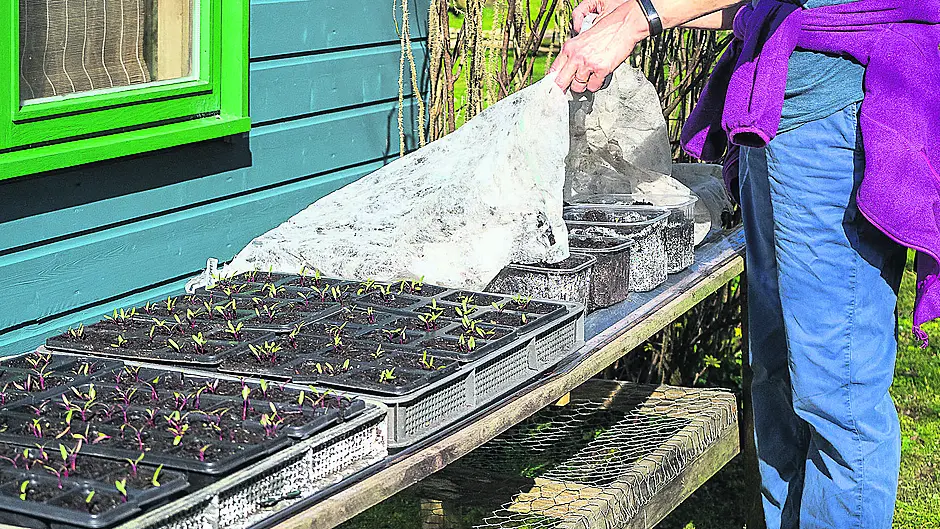BY JOYCE RUSSELL
SOWING season is in full swing and lots of seedlings are starting to show in the garden. If you have sown seeds in pots or trays in the polytunnel or greenhouse, then keep an eye on the temperature. A bright April day can push the thermometer above 30C and small seedlings in pots will suffer. Small amounts of compost heat up very fast and seeds may rot or seedlings flop before you know it.
I set up a garden table outside in a sheltered place close to the polytunnel and carry out trays of small seedlings on any fine day. I do this for seedlings that will go out in the garden as their final planting place and it helps harden them off a little while they grow. Beetroot, leeks, cabbages and Brussels sprouts all do well with this treatment. Raising trays on a table reduces problems with slugs and snails.
Tender polytunnel plants
Tomato, pepper, aubergine and cucumber plants all enjoy the warmth generated by a bit of sun. I keep these in an open propagator and only close it up when temperatures drop below 15C. As plants grow bigger they will be able to cope with temperatures a bit lower than that, but it is best not to stress small tender plants by exposing then to wide fluctuations. Stressed plants seldom crop as well as ones that have had a more steady raising regime. In another three weeks or so, I will start to harden these plants off to prepare for life in an unheated polytunnel.
Pea flowers
Mangetout peas, planted last autumn, are flowering well in the polytunnel now. Tiny pods grow quickly and the first peas will be ready to harvest soon. Pea flowers are self-fertile and mangetout flowers seem to set very well. There should be some doors or windows open to allow air to flow through and a bit of breeze helps to shake pollen down to where it is needed within the flowers. If there are any problems with setting pods, you can give a very gentle shake or run a hand along the row to mimic the windier conditions outdoors.
 Autumn sown peas are flowering now.
Autumn sown peas are flowering now.
April tulips
I always think of daffodils for March and tulips for April. There is plenty of overlap of course, where yellow trumpets mingle with red, pink, purple, orange and white colour flowers, but each of these bulbs has its moment to shine. Enjoy them while they last – it can be a brief enough time – and do the best that you can to make the most of the display.
Tulip stems can snap easily and they tend to bend over before flowers start to fade. Use small twiggy sticks to provide some discreet support and the stems will stay upright.
 Tulips bring lots of colour to the spring garden.
Tulips bring lots of colour to the spring garden.
If growing the bulbs in pots and containers you will need to keep the soil damp. Leaves can yellow if short of water – cut them off so they don’t look tatty or leave them die back once flowering is finished. You can plant the contents of the pot out into the garden, where the bulbs will flower for another couple of years.
Plant potatoes
Maincrop varieties should go into the ground in early April. You can plant them later, but early planting gives the best chance of growing good sized roots before any problems with blight arrive. In a good dry summer this is less of a problem, but, since we can’t know what weather we will get, it’s good to plant early and hedge your bets.
Early varieties, planted a couple of weeks ago, will start pushing up shoots before too long. If seed potatoes had good strong shoots then these grow quicker than small little nubs. Be vigilant and cover any emerging leaves if frost is forecast. You may already have crop cover in place, but if not, then a handful of grass clippings or a bit of compost will do the job. The leaves will push through this temporary layer and the protection provided will stop little leaves from being burned by frost.
Lovely legumes
Have you ever lamented when the last broad beans or peas are picked from a row? Well, the way to avoid this is to get out now and sow another row. You can also sow a third one at the start of May – successional sowings mean that you can keep enjoying fresh peas and beans until the summer ends.
If dwarf French beans are your favourite thing, sow a dwarf variety in trays now and plant them out when plants have two full leaves – under a cloche or when there is no risk of frost.
I wait a little while longer for sowing climbing varieties. These can grow fast and don’t like being held back in pots while they wait for frost-free nights to arrive.








